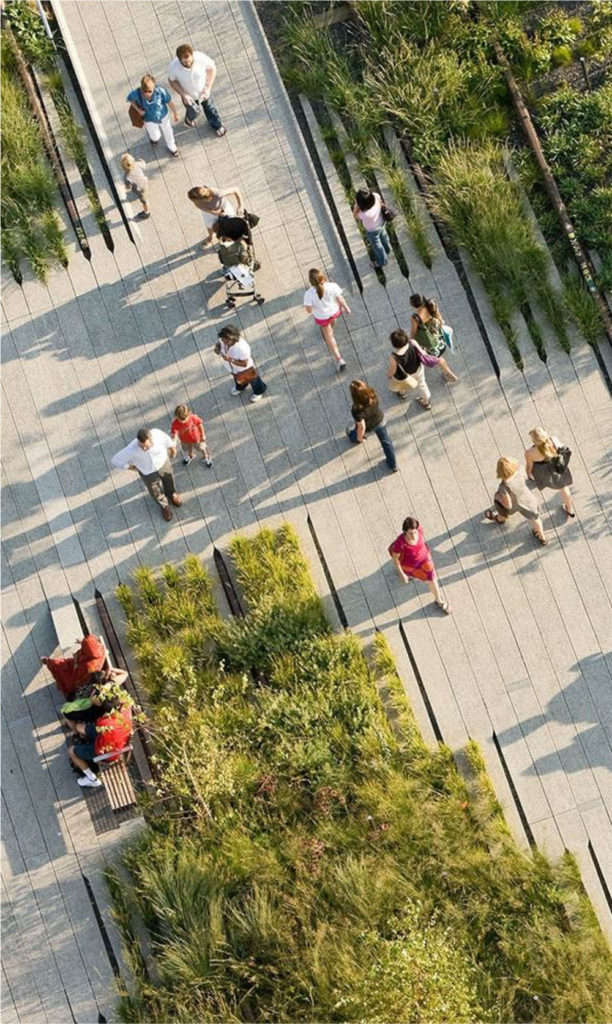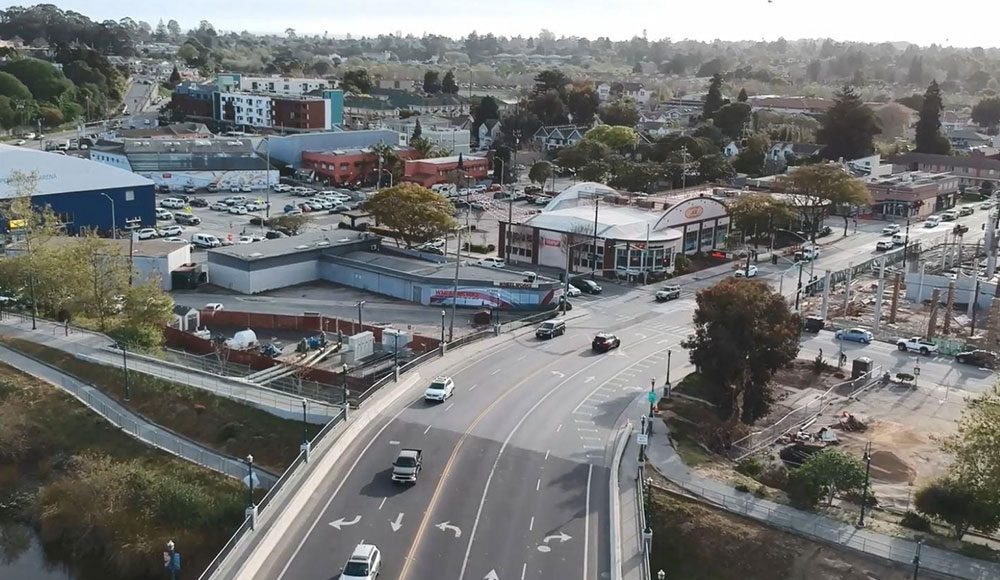A bustling neighborhood and a new 3,200-seat arena for the Santa Cruz Warriors are part of a plan to transform Downtown Santa Cruz in the coming years.
The city envisions wider sidewalks and a larger riverwalk, open-air dining on Pacific Avenue down to the beach and a pedestrianized Spruce Street in front of the future Warriors’ arena. Also, Laurel Street Extension is to be rerouted through the Front Street Residential Care Center.
At least 1,600 dwellings are planned for the 29-acre area to provide the wallets for the many restaurants and stores on the ground floor of the buildings. The Warriors’ stadium is the centerpiece of the development.
Mayor Fred Keeley has said that the city is not going to publicly finance the stadium.
The history of the city attempting to build out the area goes back to at least the 1998 Beach and South of Laurel Area Plan. In the April 30 edition of Metro Santa Cruz, the 1998 plan was described as being a “four-legged stool.” The four legs were Boardwalk expansion, a new La Bahia hotel, neighborhood renewal and transportation improvements.
Many of the plans ideas have come to pass including the new La Bahia even as the elusive “beach connection” to Downtown has remained out of reach until now.
But is the mayor’s plan realistic?
The Stadium
Keeley calls his landmark compromise on the council the “12/16/20” plan, which refers to 12 stories, 1,600 housing units and a 20% affordability rate in the South of Laurel Area District.
In 2023, Keeley addressed residents’ concerns with taller buildings by capping the height to 12-stories in the area. At the June 18 meeting, Keeley said the “12/16/20” plan was a done deal.
As the process drags on and the city’s financial commitment to the project grows, concerns are growing again.
“This has been an apple in the eye of the city for a long, long time,”Councilmember Sandy Brown said. “So flash forward 25 years, and, you know, the Warriors have come to town, there’s a real desire to keep them here. “There’s a recognition that if we do nothing, they’re definitely not going to stay. And therefore, a lot of the wheeling and dealing and the considerations that are being made are about them. And I think that’s dangerous.”
Public infrastructure in the plan is to be funded by a new “Enhanced Infrastructure Financing District.” The specialized tax district will divert new taxes collected in the zone to “partially or fully reimburse” private funding, according to the plan’s draft.

This is not a subsidy, according to Keeley. The Warriors and the Seaside Company will be funding the public improvement of the district themselves indirectly through the taxes they pay as the improvements they make raise property values.
There is nothing officially holding the Warriors in the city. They could depart for greener pastures if they were offered a better deal or wanted to consolidate with the Warriors WNBA team in San Jose. This fear is what is leading the city to perhaps give up more to the Warriors than anyone wants, according to Brown.
The Warriors are fully supportive of the development timeline.
“We’re still very much onboard with this plan,” said the team’s president Chris Murphy. “There are still so many things that are unknown. There are no concrete plans set today.”
Keeley wants faster action.
“I told the Warriors and the other interested parties here that I need you to step up and step out now. It is time for you to become more visible and for the public to see more as you move along here,” he said.
There are two potential sites for the arena: the current location and across the street, between Pacific and Front streets.
Owen Lawlor is talking to property owners about acquiring the land for a “larger project” on the block with the car dealership and Firefly Coffee House, according to a property owner who was approached. Lawlor is the developer behind the Riverfront Apartments and the Cruz Hotel.
However while the Seaside Company is onboard, Lotts Auto Stereo and other longtime owners have not yet agreed to a deal, according to this landowner.
“When I first heard about this and saw my hotel torn down and replaced by a stadium I was quite surprised,” said Joe Quigg, owner of the Pacific Blue Inn. “The owners should be the ones making the money when they sell, not the developers who come in and put the deal together and sell it to another company and make more money.”
Further up the street, Ace Hardware and Cruz Kitchen and Taps are already slated for redevelopment, according to Mia Thorn, co-owner of Cruz Kitchen. The nearby property owner who did not wish to be named said that the developer is Owen Lawlor, who didn’t respond to a request for comment.
Doubts About Number of Units, Height and Affordability
Keeley praised the planning department for “threading multiple needles, none of which are stationary, and more needles are being added as time goes on.” In other words, the Herculean task of incentivizing the construction of a stadium at the same time as the city is mandating high affordability, restricting building heights and the total number of units, the very things developers use to make a project feasible.
While the planning department proposed upzoning almost the entire area, the council pushed back with upzoning in three parcels: where the Warriors stadium is currently located on Seaside Company land, across the street at the triangular tire store lot, and at 130 Center St., where Swenson Builders has a planned 233-studio building.
With proposed developments like the Clocktower Center going 16-stories in an area zoned 35 feet, any upzoning could potentially allow developers to build more than the 1,600 units.
“Under the current density you could get the 1,600 units you want, without changing the density at all,” said Andy Schiffrin, longtime Santa Cruz County District 3 analyst. “Under the [planning department’s] proposal, it goes from 1,150 to 1,750 to 2,300 [units] so it is important to face the new reality.”
“The planning staff continues to try to obfuscate the impact,” Brown said. “How can you with a straight face say that some of the projects will not use density bonuses? Bullshit because every project that has come in since the density bonus rules has used it.”
To alleviate concerns, the city’s planning department unveiled the Santa Cruz Density Bonus, which will allow the city more control over what is built but developers will have to choose it over California density bonus laws. Once they choose the SCBD, “we will have the ability to say that the state density bonus cannot be used in conjunction with the city’s density bonus,” Planning Director Lee Butler said.
However if the developers think the California Density Bonus is more attractive then all bets are off on height. California law incentivizes affordable housing through density bonuses which allow developers to build taller than the city’s height limits.
“The basic idea is that in exchange for a density bonus, we would get more affordable units, likely at a higher affordability level (for example, moderate incomes),” wrote Planning Director Lee Butler. “As part of choosing the city’s density bonus, the developer would also have to agree to not go above 12 stories.”
Fears of Displacement
Inside the expansion zone, redevelopment’s shiny housing and tall buildings mean something different for those who work and live there.
“This is definitely the best place for the Bike Church. It is really hard to imagine if we lost this place where we would go because of the collective nature of the hub and all of its projects,” said Tessa Nefouse, an employee at the Bike Church.
The draft plan can be read here and public comment can be sent to sn****@*********ca.gov. through July 10.














Please note that saying more height and more units makes a project “feasible” for developers begs the question of how much profit is needed for a project to be “feasible.” The usual phrase, oft-repeated is “It won’t pencil out.”
Unfortunately, that rationale is unavailable to most businesses that contribute to our community when they deal with the City on challenging issues.
The following from the article sounds like Double-Think/Speak from George Orwell’s 1984. Or Gaslighting from the movie “Gaslight.”
“Mayor Fred Keeley has said that the city is not going to publicly finance the stadium.”
“Public infrastructure in the plan is to be funded by a new “Enhanced Infrastructure Financing District.” The specialized tax district will divert new taxes collected in the zone to “partially or fully reimburse” private funding, according to the plan’s draft.”
“This is not a subsidy, according to Keeley. The Warriors and the Seaside Company will be funding the public improvement of the district themselves indirectly through the taxes they pay as the improvements they make raise property values.”
So, the taxes they would be paying anyway for this new construction is being used to pay their own business loans for building this. Seems that they ARE being reimbursed—-partially or fully…….Right?